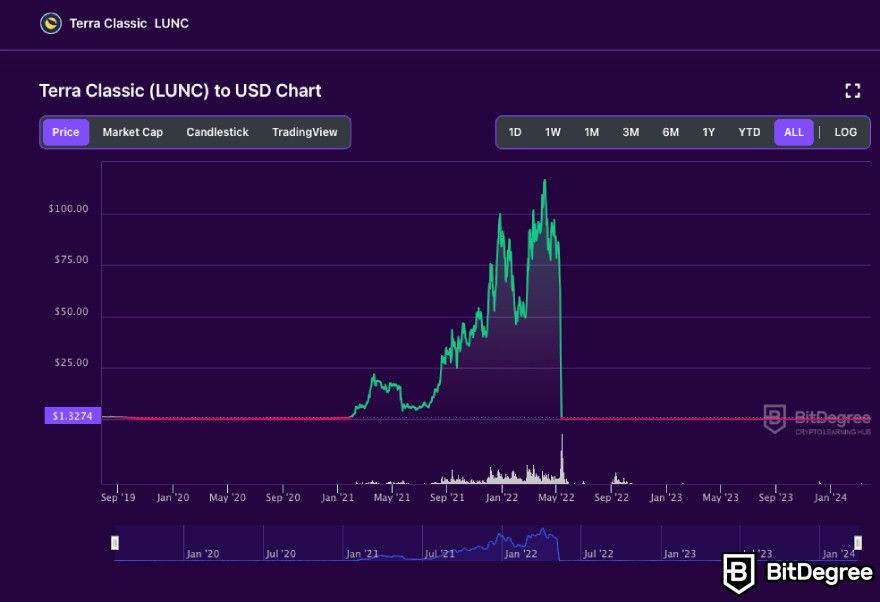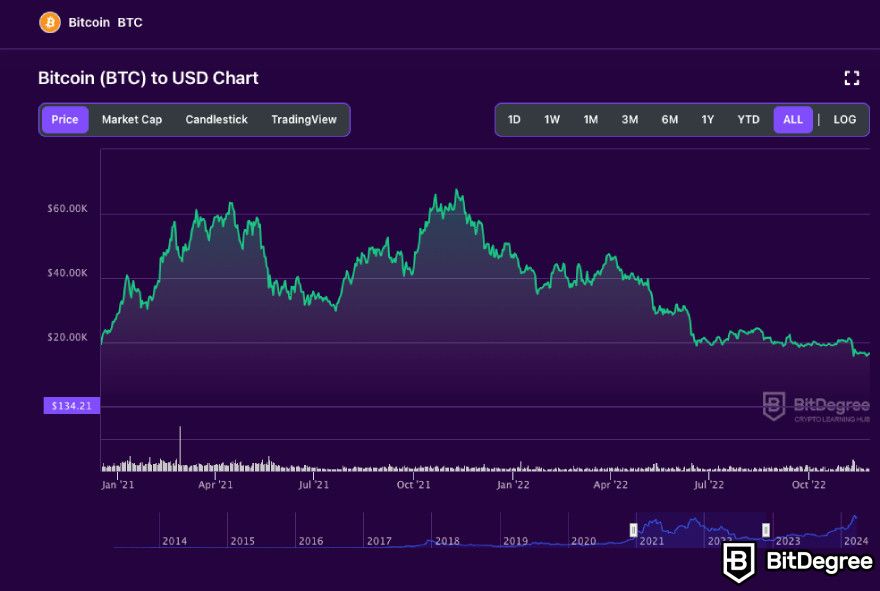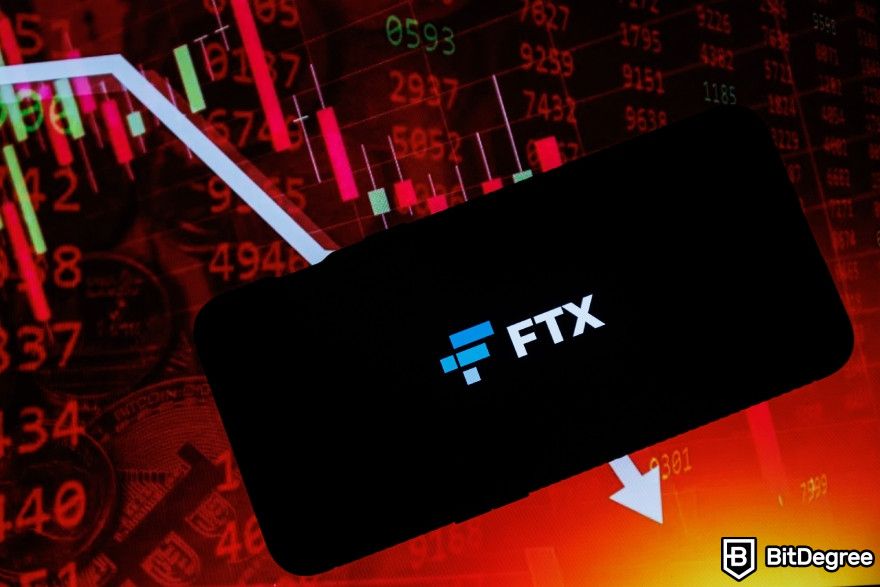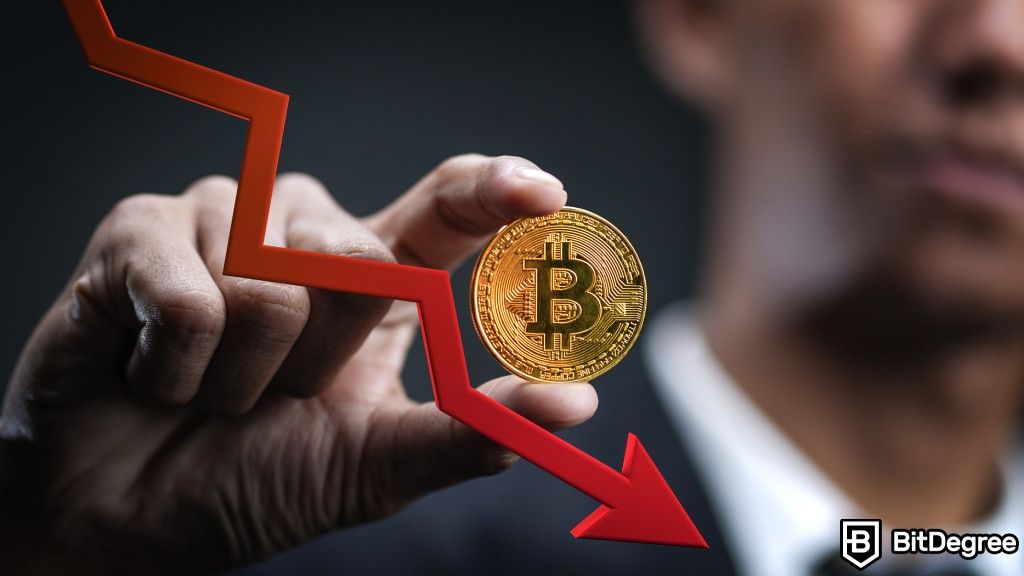Key Takeaways
- Market volatility, regulatory challenges, speculation, market sentiment, and economic crisis, among other factors, can all be the underlying causes of why crypto is crashing in a given period of time;
- The right strategies and knowledge can help you get through crypto crashes, and maybe even profit from them;
- 2022 was the year that saw many unexpected and noteworthy crypto market crashes.
Free Airdrop Season 7 is LIVE! Answer fun questions or do simple tasks to earn rewards from the $30K BitDegree prize pool. Participate Now ! 🔥
If you keep an eye on the crypto market, you probably often ask yourself, "Why is crypto crashing or rising?". After all, cryptocurrencies seem to always be on a wild and unpredictable journey.
With prices soaring to the moon one day, only to come crashing back down the next, many are resolving to such Google inquiries as, "Is crypto dying?" or "Why cryptocurrency market is down today?". Thus, I'll dive deep and try to unravel the mysteries behind crypto market crashes so you can make sense of the chaos.
As a side note, remember to protect your assets by only engaging with reputable and trustworthy crypto exchanges, such as Binance, Bybit, or Kraken.

Did you know?
Subscribe - We publish new crypto explainer videos every week!
What is Fantom? | Animated FTM Explainer


Table of Contents
- 1. Why is Crypto Crashing: The Main Causes of Doom
- 1.1. Technological Factors
- 1.2. Regulatory Challenges
- 1.3. Market Sentiment and Speculation
- 1.4. External Economic Factors
- 2. The Biggest Crypto Crashes
- 2.1. The Terra Luna Crash
- 2.2. The 2022 Bitcoin Sell-Off
- 2.3. Crypto Market Shock After the FTX Bankruptcy
- 3. How to Navigate a Crypto Crash?
- 4. Conclusions
Why is Crypto Crashing: The Main Causes of Doom
You've probably heard the buzzwords "crypto crash" or "crypto market turbulence" more times than you can count. These roller coaster rides in the digital currency space have left many investors scratching their heads and wondering, "Why is crypto crashing again?".
Latest Deal Active Right Now:Head to BitDegree Missions, gather as many Bits as possible & claim your stake of the $30,000 Prize Pool! Don't waste your time & start collecting Bits by completing Missions and referring friends.
Well, you're not alone in seeking answers.
So, let's explore the fundamental reasons behind these persistent price declines that seem to haunt the crypto market, not just in recent times but throughout its relatively short yet eventful history.
After understanding these key points, instead of thinking, "Is crypto over?", you'll be able to analyze some of the events that anticipate a crypto market crash. In doing so, Googling "Why cryptocurrency market is down today?" might become a thing of the past.
Crypto markets often experience many ups and downs. Market volatility is a fundamental reason behind the persistent price declines in the cryptocurrency space, and it can usually be the short and simple answer to "Why is crypto crashing?".

Cryptocurrencies, being relatively new and less regulated, are more prone to extreme price swings. These sharp fluctuations can be triggered by various factors, including large trades, news events, and changes in market sentiment.
The absence of a central authority regulating cryptocurrencies, as opposed to traditional financial markets, contributes to their inherent volatility.
It's important to remember that, in times of uncertainty, traders tend to make hasty decisions, which can lead to abrupt price movements and, sometimes, a crypto market crash.
Moreover, the lack of liquidity in some cryptocurrencies makes them particularly susceptible to price manipulation. Market manipulation schemes, such as Pump and Dump (P&D) schemes, can artificially inflate prices and then lead to dramatic crashes when the perpetrators exit the market.
All in all, crypto market volatility is a complex blend of speculation, regulation (or the lack thereof), news, emotions, liquidity, technological risks, and external influences. It's this mix of factors that make the crypto so thrilling, albeit a little nerve-wracking. Now, let's explore these factors in more detail.
Technological Factors
One of the fundamental technologies underpinning cryptocurrencies is blockchain, which, simply put, is a decentralized ledger that records all transactions. However, blockchain technology is not without its problems. Sometimes, it can even be the answer to the "why is crypto crashing" conundrum.
For example, scalability issues are a constant concern.
As more people and institutions adopt cryptocurrencies, the blockchain's capacity to handle transactions can become strained. This can lead to slower processing times and higher fees. When these issues persist, they can undermine the attractiveness of cryptocurrencies for everyday use and become a reason for why crypto is crashing.
The security of cryptocurrencies is another key technological factor influencing their value.

While blockchain technology is inherently secure, it's not immune to hacking, fraud, and vulnerabilities. High-profile crypto exchange hacks and wallet breaches have eroded trust in the system, and questions like "Is crypto over?" or "Is crypto dying?" begin to pop up everywhere.
With investors worrying about the safety of their digital assets, many might decide to pull out, causing prices to drop, which further increases any crypto crash.
But why is crypto crashing related to blockchain technology advancements too? Well, in the world of cryptocurrency, innovation is a double-edged sword.
New coins and tokens are regularly introduced, each with its unique features and use cases. While innovation can drive the market's growth, it can also lead to saturation. When too many alternatives flood the market, it can disperse investments and weaken the value of existing cryptocurrencies.
Moreover, competition among projects can sometimes result in disputes and forks, further destabilizing the market.

Cryptocurrencies are continually evolving. Network upgrades and forks are common occurrences. While these are intended to improve the technology, they can also cause temporary disruptions.
Disagreements within the community over these changes can lead to splits in the blockchain, resulting in two separate cryptocurrencies, like Bitcoin and Bitcoin Cash. This can create uncertainty, affecting the market's stability.
In the ever-evolving world of technology, what's cutting-edge today might become outdated tomorrow. Investors are always on the lookout for the next big thing. If a cryptocurrency project can't keep up with technological advancements, its value may dwindle.
Regulatory Challenges
Unlike traditional financial markets, the digital nature of cryptocurrencies makes crypto markets a unique entity in the eyes of governments and financial authorities worldwide.
The lack of a unified global regulatory framework has led to a patchwork of rules and guidelines, and this regulatory uncertainty can end up turning into the cause of why crypto is crashing. The question of whether cryptocurrencies should be considered as securities, commodities, or something entirely new remains a hot topic of debate.
Various countries have taken diverse approaches to regulating cryptocurrencies, and these differing stances often create confusion and uncertainty.
Some nations, like Japan, have embraced cryptocurrencies with open arms, establishing clear regulations to govern their use. In contrast, others, like China, have imposed strict bans and crackdowns, sending shockwaves through the market.

The uncertainty surrounding regulatory developments can make investors nervous. When governments announce new regulations or make sudden changes to their stance on cryptocurrencies, it can lead to sharp price declines.
Investors fear potential legal implications, and this uncertainty often leads to panic selling, contributing to the crypto market's volatility.
Moreover, regulatory challenges extend beyond national borders.
International organizations, such as the Financial Action Task Force (FATF), are working towards creating a global framework for regulating cryptocurrencies to combat money laundering and other illicit activities. These efforts can also influence the market's behavior and contribute to price declines.
In summary, regulatory challenges are a significant factor behind the crypto market's wild price fluctuations. The lack of a consistent, global framework, coupled with varying national stances and international efforts, creates an atmosphere of uncertainty that can lead to panic and increased market volatility.
Market Sentiment and Speculation
Cryptocurrencies are unique because they rely heavily on people's feelings about them. Their prices don't just follow a simple supply-and-demand curve; they also dance to the tune of public sentiment.
You see, crypto is not like traditional stocks or bonds, which have established cash flows and earnings. Instead, it's driven by the beliefs and speculations of the investors.
So, why is crypto crashing? Sometimes, it's simply because of how everyone is feeling.
When the crypto market is soaring, euphoria abounds. People rush to buy, and the prices skyrocket. It's the time for FOMO. Everyone seems to be making money, and the fear of being left behind drives more people into the market.
Conversely, when the market is in a downward spiral, panic sets in. It's the time for FUD. People start selling because they fear losing even more. This fear fuels a self-perpetuating cycle of declining prices.
What's intriguing is that there's often no concrete reason behind these swings. Instead, it's all about how investors perceive the situation. A tweet from a prominent figure or a news article can trigger a massive shift in sentiment[1].
People tend to buy when they think a cryptocurrency will increase in value, not necessarily because it has intrinsic value. They also sell when they believe it's going down, without necessarily knowing why. This herd mentality is a significant driver of volatility.

The power of market sentiment is evident in the 2017 crypto boom. Bitcoin's price went from below $1 to nearly $20,000 that year, driven primarily by the excitement and belief that cryptocurrencies were the future.
But then the sentiment shifted, and the market crashed. Bitcoin's price fell by about 65% in the first two months of 2018, and everyone was left wondering, "Why is crypto crashing now?".
To put it short, market sentiment and speculation can create astronomical gains, but they can also lead to catastrophic losses.
Investors must be cautious and not let emotions guide their decisions. This is why understanding the emotional side of the crypto market is crucial for anyone hoping to navigate the roller coaster of price swings.
External Economic Factors
The cryptocurrency market is not isolated from the broader global economy. As such, external economic factors can have a substantial impact on price trends. These factors extend beyond the cryptocurrency market itself and often influence investors' decisions and market sentiment.
One key external factor is global economic stability. So, why is crypto crashing during tough times?
When traditional financial markets experience turbulence, such as a recession or a major economic crisis, cryptocurrency prices can react in various ways.
Some investors may flock to cryptocurrencies as a hedge against economic uncertainty, driving up prices. Conversely, others may liquidate their crypto holdings to cover losses in traditional markets, causing a decline.
Additionally, as I've mentioned before, government policies and regulations play a pivotal role.
Cryptocurrencies often face scrutiny from regulatory bodies and lawmakers. News of impending regulations or government actions can trigger panic selling or buying in the crypto market, depending on the perceived impact of those regulations.

Geopolitical events and global crises, such as trade wars, political instability, pandemics, or international conflicts, can also have a ripple effect on cryptocurrency prices[2].
When facing geopolitical uncertainty, some investors might seek cryptocurrencies as a refuge to preserve their wealth, while others may liquidate their assets to navigate tough times. Besides that, anticipating a potential crypto market crash, many might opt to sell their holdings.
Furthermore, changes in the global economic landscape, such as shifts in monetary policy or inflation rates, can influence the value of cryptocurrencies like Bitcoin, which is often dubbed "digital gold". Investors may see cryptocurrencies as a safe haven or a diversification tool in response to such changes.
Understanding how external economic factors can affect the cryptocurrency market is essential for traders and investors, as it allows them to anticipate and adapt to price movements driven by events beyond the crypto sphere.
The Biggest Crypto Crashes
Now it's time to explore some of the most significant crypto market crashes that have recently rocked the digital landscape. Let's take some time to understand these events that have left many investors puzzled, often asking the same old question: "Why is crypto crashing?".
By analyzing these cases, you can better understand what led all the crypto investors into a frenzy of "is crypto dying", "why cryptocurrency market is down today", and "is crypto over" types of Google searches.

Did you know?
Subscribe - We publish new crypto explainer videos every week!
What Does Staking Mean in Crypto? (Easily Explained!)


The Terra Luna Crash
The Terra Luna crypto crash of 2022 sent shockwaves through the cryptocurrency world. With a jaw-dropping price fall of -99.9991%, it stands as one of the darkest chapters in crypto history.
LUNA, Terra's native token, plummeted from a lofty $116 to a mere $0.0001, highlighting the extreme volatility of the crypto market.
Before the crash, Terra Luna was a heavyweight in the crypto realm, ranking among the top 10 largest coins by market capitalization and enjoying immense popularity. But then came the catastrophic plunge.
But why is crypto crashing even with such a solid historical performance?
The crash was triggered by the instability of Terra's stablecoin, UST, which failed to maintain its $1 peg. This failure unleashed panic selling, resulting in the colossal wipeout of LUNA's value.
To understand why Terra Luna, a once-beloved project, crashed so dramatically, we need to delve into what Terra, LUNA, and UST are.

Terra, founded in 2018, is a blockchain platform specializing in stablecoins and decentralized applications. LUNA is its native cryptocurrency for transactions, governance, and staking. UST is Terra's algorithmic stablecoin, aiming to maintain a $1 value by adjusting LUNA supply.
So, in this context, why is crypto crashing? Why did LUNA crash?
Before the catastrophic descent, approximately $2 billion worth of UST was unstaked from the Anchor Protocol, followed by a massive sell-off of hundreds of millions. The reasons behind this action remain unclear, but some suspect it was a malicious attack on the Terra ecosystem.
This sell-off drove UST's price down to $0.91, prompting a rush to exchange UST for LUNA, as 1 UST could always be redeemed for $1 worth of LUNA.
However, simultaneously, the broader crypto market was in turmoil, leading to a sharp decline in LUNA's price.
When the market capitalization of LUNA fell below that of UST, a problem emerged because UST relied on LUNA for stabilization. With UST losing its peg, confidence in the coin plummeted, causing a rapid devaluation of LUNA.

In a remarkably short span of time, the algorithm meant to maintain UST's $1 value faltered.
The synchronized crash of UST and LUNA led investors to offload their holdings on the open market. The flood of LUNA onto crypto exchanges, coupled with UST's de-pegging, shattered investor confidence and rendered LUNA nearly worthless.
The aftermath saw LUNA and UST delisted from major crypto exchanges worldwide.
While Do Kwon (Terra's co-founder) did devise a plan to resuscitate the cryptocurrency, crypto experts remain skeptical about the prospects of the newly forked LUNA reclaiming the former LUNA (now LUNC) glory. The Terra Luna crash serves as a stark reminder of the volatility and unpredictability that continue to define the cryptocurrency landscape.
The 2022 Bitcoin Sell-Off
In 2022, the world of cryptocurrencies experienced extreme turbulence that left investors in a state of shock and disbelief. The panic selling that year had a profound impact on the digital asset market, and Bitcoin, the kingpin of cryptocurrencies, took a devastating hit, plummeting by a staggering 72.44%.
This downward spiral wasn't just a temporary hiccup, though. It gained momentum, causing substantial losses in the process. Bitcoin, which once soared to an impressive high of $69,044, came crashing down to a modest $19,047, leaving investors reeling in its wake.
At the beginning of 2022, enthusiasm for cryptocurrencies was at an all-time high, with many digital currencies reaching stratospheric heights. "To the moon!" was the expression of the moment.
However, a few months later, it all came crashing back down to Earth. Bitcoin's value had dwindled to roughly a quarter of its value from a year prior, and the industry was grappling with the aftermath of the catastrophic implosion of the cryptocurrency exchange FTX.
2022 might be remembered as a turning point for the world of virtual currencies, where they lost their luster and were regarded with skepticism and caution by most. Alternatively, it could simply be seen as a period of excruciating growing pains for an industry still in its infancy.

In any case, 2022 was a year that etched its place in the crypto history books. The hype around cryptocurrencies at the beginning of the year was palpable. Crypto companies were investing tens of millions in marketing, even flooding the Super Bowl with commercials.
The industry seemed to reach its "peak hype" in January and February as prices hit all-time highs, and people were making what seemed like irrational amounts of money. Even celebrities like Paris Hilton were getting in on the action, discussing non-fungible tokens (NFTs) on national television. But the peak hype didn't last long.
The Federal Reserve's decision to raise interest rates in an attempt to combat high inflation sent shockwaves through the crypto market. Many believed that cryptocurrencies, particularly Bitcoin, would serve as an inflation hedge like gold.
However, the reality was different as the value of Bitcoin started falling, defying predictions.
The prolonged crypto winter that began before 2022 reached its halfway point. Individual investors who had bought digital assets near their peak saw their investments dwindle. But more alarmingly, systemic issues within the industry came to the forefront. Many crypto firms were exposed as overextended, with poor risk management, or involved in fraudulent activities.

- Secure and reliable
- Accepts fiat currencies
- Lots of trading options
- Reputable exchange
- Accepts fiat currencies
- Offers various trading options

- Fiat currencies - accepted
- Simple to use
- Accepts only the most trustworthy cryptocurrencies
- A leading cryptocurrency exchange platform
- Best for beginner investors
- Accepts fiat currencies

- Beginner-friendly
- Secure
- Decent trading and withdrawal fees
Crypto Market Shock After the FTX Bankruptcy
The time has come for us to talk about a painful stain in crypto history I've already briefly mentioned in the previous subchapter: FTX bankruptcy. It's not a crypto crash in itself, but it is a reason that shook up the crypto market pretty strongly.
FTX, a major cryptocurrency exchange, and its US branch, FTX.US, filed for Chapter 11 bankruptcy on November 11, 2022. This move came after a series of dramatic events that left investors stunned.
The former founder and CEO, Sam Bankman-Fried, added more fuel to the fire when he was arrested on December 12 in the Bahamas and later extradited to the US, where he pleaded not guilty to eight criminal charges, including wire fraud and conspiracy to defraud investors.
The Securities and Exchange Commission (SEC) complaint revealed startling news: Bankman-Fried had been using customer funds as his "personal piggy bank" for private investments, including real estate and political campaign donations.
The crypto community was left in shock as trust in the industry took a significant hit.

Following the bankruptcy filing, the new CEO of FTX, John J. Ray III, came forward and exposed the severity of the exchange's financial woes. He cited a "complete failure of corporate controls" and a "complete absence of trustworthy financial information".
FTX's crash had ripple effects across the crypto market, affecting cryptocurrencies and exchanges with exposure to FTX and its native token, FTT, leading to sinking prices and financial troubles[3]. Even exchanges with minimal or no involvement with FTX took a hit.
So, what exactly led to the downfall of FTX and FTX.US? The answer lies in a combination of factors, primarily a lack of liquidity and mismanagement of funds, which triggered a wave of investor withdrawals.
This catastrophic chain of events caused the value of FTT to plummet, dragging other cryptocurrencies like Ethereum and Bitcoin down with it.
The crash of FTX serves as a stark reminder of the vulnerabilities and risks that exist within the crypto market, emphasizing the importance of transparency, regulatory compliance, and robust financial controls in the industry.
How to Navigate a Crypto Crash?
Navigating a crypto crash can be daunting, but it's not a lost cause. Now, I'll show you some strategies and tips to help you weather the storm and potentially turn a crypto market crash into an opportunity. This way, instead of desperately asking, "Why is crypto crashing again?", you'll be prepared to face it.
Just keep in mind that I'm not here to give you financial advice – just ideas you can incorporate in your portfolio after DYORing and finding out what suits your goals best.
Stay Calm and Avoid Panic Selling
The first rule of navigating a crypto crash is to stay calm. Emotions can run high during a market downturn, leading to impulsive decisions. One of the most common mistakes is panic selling.
Selling during a crash often locks in losses, making it challenging to re-enter the market at the right time. So, take a deep breath and resist the urge to make hasty decisions. Remember, crypto market crashes are usually followed by recoveries.
Conduct Thorough Research
During a crypto crash, you can use your time wisely by conducting in-depth research on cryptocurrencies and blockchain projects. Test their fundamentals, technology, and long-term potential.

This information will prove invaluable when identifying investment opportunities as the market begins to recover. Knowledge is your best ally in the crypto world.
If you want to learn about Web3, investment strategies, blockchain technology, and more, be sure to check out the BitDegree Missions and Web3 Exam. There, you'll learn a lot of information that'll help you navigate the crypto landscape with confidence, and you'll even do that in a gamified and incentivized manner.
HODL
The HODL strategy, short for "hold on for dear life", is a popular approach during market crashes. It involves buying and holding cryptocurrencies for the long term, regardless of short-term market trends. This strategy is based on the belief that certain assets have the potential for long-term performance.
By holding onto your investments, you can ride out the storm and potentially benefit from future growth.
Just keep in mind that this does not apply to all assets or risk appetites. Remember to DYOR and decide whether this strategy is for you or not.
Diversify Your Portfolio
Diversification is a risk management strategy that can help protect your investments during a crypto market crash.

By spreading your investments across various cryptocurrencies and asset classes, you reduce your exposure to any single asset's risk. This increases the likelihood of preserving your capital.
Set Stop-Loss Orders
Setting stop-loss orders can be a lifesaver. These are predefined levels at which you're willing to sell an asset to limit potential losses.
By setting stop-loss orders, you automate part of your risk management and avoid emotional decision-making. This tool can protect your investments even when you're not actively monitoring the market.
Use Automation Tools
Automation is a game-changer in the crypto market. With trading bots and automation software, you can set up price-targeted trades and safeguard your investments.
The crypto market operates 24/7, which means that turbulence can strike at any moment. Using automation mechanics can help you avoid unnecessary risk. Of course, don't rely on them blindly, all automation tools require human supervision.
All in all, navigating a crypto crash requires a thoughtful approach, careful decision-making, and a long-term investment perspective. While market downturns can be disheartening, they also present unique opportunities for well-informed and prepared investors.
Remember to stay calm, conduct research, consider the HODL strategy, diversify your portfolio, set stop-loss orders, and leverage automation tools to minimize risk and make the most of your crypto investments during challenging times.
Conclusions
So, why is crypto crashing? Well, there are many reasons, which is why navigating a crypto crash demands a prudent and deliberate approach. It may seem disheartening when the values plummet, but remember, every dip in the crypto market represents a chance for well-informed and prepared investors.
By understanding the underlying causes and taking measured steps, you can ride out the storm and emerge stronger. So, whether you're a seasoned trader or a curious newcomer, stay informed, stay patient, and seize the opportunities that crypto crashes can bring.
Besides that, always engage with trading platforms that offer top-tier security, like Binance or Bybit, but consider storing your crypto assets in a hardware wallet, like Ledger Nano X, to avoid getting sucked into any bankruptcy-related drama.
The content published on this website is not aimed to give any kind of financial, investment, trading, or any other form of advice. BitDegree.org does not endorse or suggest you to buy, sell or hold any kind of cryptocurrency. Before making financial investment decisions, do consult your financial advisor.
Scientific References
1. M. Bhatnagar, S. Taneja, R. Rupeika-Apoga: 'Demystifying the Effect of the News (Shocks) on Crypto Market Volatility';
2. Z. Umar, M. Gubareva: 'A Time–Frequency Analysis of the Impact of the Covid-19 Induced Panic on the Volatility of Currency and Cryptocurrency Markets';
3. U. Chohan: 'FTX, Cryptocurrencies, and Anarchism Ignored'.














